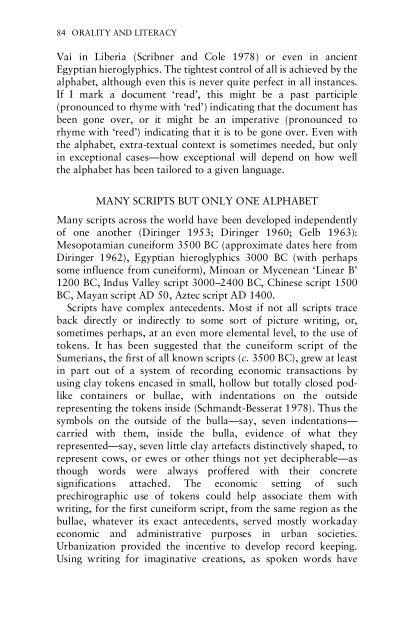Orality and Literacy: The Technologizing of the Word - Monoskop
Orality and Literacy: The Technologizing of the Word - Monoskop
Orality and Literacy: The Technologizing of the Word - Monoskop
You also want an ePaper? Increase the reach of your titles
YUMPU automatically turns print PDFs into web optimized ePapers that Google loves.
84 ORALITY AND LITERACY<br />
Vai in Liberia (Scribner <strong>and</strong> Cole 1978) or even in ancient<br />
Egyptian hieroglyphics. <strong>The</strong> tightest control <strong>of</strong> all is achieved by <strong>the</strong><br />
alphabet, although even this is never quite perfect in all instances.<br />
If I mark a document ‘read’, this might be a past participle<br />
(pronounced to rhyme with ‘red’) indicating that <strong>the</strong> document has<br />
been gone over, or it might be an imperative (pronounced to<br />
rhyme with ‘reed’) indicating that it is to be gone over. Even with<br />
<strong>the</strong> alphabet, extra-textual context is sometimes needed, but only<br />
in exceptional cases—how exceptional will depend on how well<br />
<strong>the</strong> alphabet has been tailored to a given language.<br />
MANY SCRIPTS BUT ONLY ONE ALPHABET<br />
Many scripts across <strong>the</strong> world have been developed independently<br />
<strong>of</strong> one ano<strong>the</strong>r (Diringer 1953; Diringer 1960; Gelb 1963):<br />
Mesopotamian cuneiform 3500 BC (approximate dates here from<br />
Diringer 1962), Egyptian hieroglyphics 3000 BC (with perhaps<br />
some influence from cuneiform), Minoan or Mycenean ‘Linear B’<br />
1200 BC, Indus Valley script 3000–2400 BC, Chinese script 1500<br />
BC, Mayan script AD 50, Aztec script AD 1400.<br />
Scripts have complex antecedents. Most if not all scripts trace<br />
back directly or indirectly to some sort <strong>of</strong> picture writing, or,<br />
sometimes perhaps, at an even more elemental level, to <strong>the</strong> use <strong>of</strong><br />
tokens. It has been suggested that <strong>the</strong> cuneiform script <strong>of</strong> <strong>the</strong><br />
Sumerians, <strong>the</strong> first <strong>of</strong> all known scripts (c. 3500 BC), grew at least<br />
in part out <strong>of</strong> a system <strong>of</strong> recording economic transactions by<br />
using clay tokens encased in small, hollow but totally closed podlike<br />
containers or bullae, with indentations on <strong>the</strong> outside<br />
representing <strong>the</strong> tokens inside (Schm<strong>and</strong>t-Besserat 1978). Thus <strong>the</strong><br />
symbols on <strong>the</strong> outside <strong>of</strong> <strong>the</strong> bulla—say, seven indentations—<br />
carried with <strong>the</strong>m, inside <strong>the</strong> bulla, evidence <strong>of</strong> what <strong>the</strong>y<br />
represented—say, seven little clay artefacts distinctively shaped, to<br />
represent cows, or ewes or o<strong>the</strong>r things not yet decipherable—as<br />
though words were always pr<strong>of</strong>fered with <strong>the</strong>ir concrete<br />
significations attached. <strong>The</strong> economic setting <strong>of</strong> such<br />
prechirographic use <strong>of</strong> tokens could help associate <strong>the</strong>m with<br />
writing, for <strong>the</strong> first cuneiform script, from <strong>the</strong> same region as <strong>the</strong><br />
bullae, whatever its exact antecedents, served mostly workaday<br />
economic <strong>and</strong> administrative purposes in urban societies.<br />
Urbanization provided <strong>the</strong> incentive to develop record keeping.<br />
Using writing for imaginative creations, as spoken words have

















